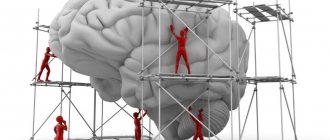What is synesthesia
The concept of synesthesia is easy to define by translating the term itself: “syn” - together, “esthesis” - sensations. At the junction of the two words, the concept of “connected sensations” arises, and this is the most accurate description. With this phenomenon, 2 unrelated feelings begin to be associated with each other despite human will. A synesthete may believe that Tuesday is green and that a pet's name has a salty taste.
There are many similar cases in history. Many famous artists, writers and musicians noted this feature.
The main criterion for its diagnosis is the involuntary occurrence of manifestations. This distinguishes it from simply a well-developed fantasy that is controlled by the person himself.
The reasons for this phenomenon
Science has not fully studied either it itself or its mechanisms, but scientists were still able to make an assumption about the reasons for the appearance of such a phenomenon of perception.
The main possible ways of occurrence of this neurological feature are identified:
- Congenital synesthesia is the simplest explanation. Some researchers are inclined to believe that all people are synesthetes from birth. Later, when the child learns to perceive the world in traditional associations and categories, synesthetic manifestations recede as the brain establishes generally accepted connections between the senses. And only 4% of people retain this feature.
- Unusual connections between different parts of the central nervous system, the causes of which are still unknown. The entire process of thinking in the human brain is a consequence of the interaction of a large number of neurons united in a network. Sometimes there is a shift or the establishment of unusual neural connections. This leads to the fact that one sensation activates another, uncharacteristic for it.
- Disturbances in the myelin coating of neurons. This shell protects them from unnecessary interactions. With partial thinning of the myelin layer, contacts arise between parts of the brain that are independent of each other.
Synesthesia occurs due to non-standard connections between sections of the central nervous system.
There have also been cases of short-term synesthesia that developed as a result of the negative effects on the central nervous system of intoxications, injuries, and diseases affecting brain activity.
Is life easy for synesthetes?
The presence of a diagnosis does not in any way prevent its owner from perceiving and comprehending information. In addition, due to the expanded associative range, synesthetes can take a non-standard approach to various types of activities.
Hyperekplexia
Hyperekplexia manifests itself in the first hours of a child’s life
. It happens that ordinary touches cause strange reactions in the brain. For example, a simple touch can trigger a seizure in a newborn baby with hyperekplexia. Any unexpected movements or loud noise can cause the same effect. The muscles of the throat and chest become ossified, and the limbs become “wooden”. The child may even stop breathing. The worst thing is that if someone tries to calm the child, the symptoms usually only get worse.
Step-by-step plan for making money by setting up VKontakte advertising
Learn VKontakte advertising in 3 days and start earning money remotely from RUR 50,000. per month.
Sign up for training
Hyperekplexia is a rare neurological disorder that causes seizures and is sometimes misdiagnosed as epilepsy. It is caused by mutations in just two genes. Because of this, the nerve cells in the brain begin to communicate incorrectly.
One little girl developed symptoms of hyperekplexia within hours of birth. “I felt some abnormal movements in my stomach in the last months of pregnancy, sometimes 10-15 times a day,” said her mother Abby. “Immediately after birth, she had a terrible attack - she turned blue and trembled all over. I was very scared". Note that in the most serious cases, hyperekplexia can lead to sudden death.
Types of synesthesia
Synesthesia is a broad concept; it includes many subtypes. People with this diagnosis may exhibit very different chains of associations. Cognitive scientists identify about 80 types of atypical connections. The most common are 6 of them.
Grapheme-color
This type of synesthesia is more common than others. Symbols and signs (numbers, letters, etc.) acquire color. A person cannot explain why for him 8 is a purple hue, and the letter U is red. Often people with this trait have an extraordinary memory for numbers and text.
Phonopsia
Acoustic-color synesthesia, or phonopsia, is a phenomenon in which sounds and melodies are colored in color in human perception. If the sound of birds is associated with the color blue, but the recording of your favorite musician has a green tint, we are talking about phonopsia, a sound type of synesthesia.
Phonopsia is a condition in which sounds are colored.
Kinetic-auditory
Looking at a moving object, a person involuntarily hears sounds, and they are not related to each other. The appearance of the hum of an engine when looking at a moving car is not a manifestation of synesthesia, but the heard murmur of water with the same picture is an illustrative example of kinetic-auditory synesthesia, also called chromesthesia.
Phoneme-gustatory
If the interlocutor claims that his pet's name tastes salty, and the name of the neighboring store tastes sweet, in this case the sounds are associated with different tastes.
Acoustic-tactile
In this form of synesthesia, heard sounds are felt by touching different parts of the body. Some researchers also attribute to it the phenomenon of ASMR, which has become very famous in the last decade - autonomous sensory meridional response. With it, some sounds evoke goosebumps, tingling and other pleasant sensations. Whether there is a relationship between these 2 cognitive characteristics remains to be determined by scientists.
Why is this happening
Little is known about how synesthesia develops. It is thought to develop during childhood, when children first intensively learn and engage with abstract concepts. This hypothesis, called the semantic vacuum hypothesis, explains why the most common forms of synesthesia are grapheme-color, spatial sequence, and number form. Moreover, one 2006 study documented a case of synesthesia in which synesthetic associations could be traced to colored magnets on a refrigerator. Despite the existence of this isolated case, most synesthetic associations do not seem to be driven by learning of this kind.
Theories
Several theories have been proposed to try to explain the mechanisms behind these unique sensations. The two most well-known theories are cross-activation theory and feedback theory. Both of these theories have different evidence to support their validity.
Cross activation theory
Feedback theory
Typically, input from multiple areas of the brain is sent to a multisensory processing area that links the information together. According to this theory, a neural signal entering a processing area can activate other initially unactivated areas through feedback.
For example, when viewing the grapheme stimulus “A,” signals are transmitted to the multisensory processing area, which causes activation of feedback that sends a signal to the color area responsible for the perception of red. Feedback theory suggests that in people who are not synesthetes, this feedback is also present, but is usually inhibited.
This is interesting: Hallucinations are a side effect of the brain overinterpreting information
As evidence for this theory, researchers point to the ability of drugs and medications to induce synesthetic experiences in people who are not synesthetes.
As you already understand, there is no consensus on the mechanisms underlying this phenomenon. Moreover, recently, thanks to the advent of new technologies, researchers have also been able to discover genes that are believed to contribute to synesthesia.
Genetics
Researchers have already recognized an inherited tendency for synesthesia. This observation was first noted by Francis Galton in 1883, and several studies have subsequently confirmed it. A genetic factor may explain why a person with one form of synesthesia may also have another form, since genes are expressed throughout the brain and affect multiple modalities.
Triggers of synesthesia
From the term itself it follows that the appearance of non-standard associative reactions is a consequence of the initial signal received by the senses. Moreover, most often the reaction is triggered not by the impact itself, but by the thought of it, its perception by the brain.
The appearance of non-standard reactions is a consequence of a signal to the brain.
This is easily proven by an experiment with fictitious phenomena. In them, the synesthete is asked to imagine some non-existent object that complements the chain of real ones - the 8th day of the week, an extra month, etc. Unreal things also evoke synesthetic associations. From this we can conclude that the trigger is the activation of mental processing of the received signal.
Is it possible to become a synesthete?
Synesthesia is an involuntary phenomenon: it is unlikely that a person will “unsee” the colors of notes or stop smelling the days of the week at will. The likelihood of becoming a true synesthete in midlife is also low. The experience of synesthesia (most often, various sensory associations with musical sounds and rhythms) can be provided by psychedelics - but such experiences, as a rule, end with the effect of the drug.
However, medicine knows of rare cases when, due to a violation of certain processes in the brain, a person acquired synesthetic abilities. The most sensational story happened with a forty-five-year-old resident of Toronto. In 2007, a man suffered a stroke, and 9 months later he began to experience strange sensations: words written in a certain color began to irritate him, blue began to be associated with the smell of raspberries, and when he heard the main theme from the Bond films, the Canadian fell into real ecstasy - although by no means Was not a fan of Ian Fleming. Frightened, the man turned to doctors. An MRI scan helped to find out the reason: the patient’s brain, which had suffered from a stroke, was trying to recover by forming chaotic connections between neurons.
Is it possible to develop synesthesia yourself?
Unconventional thinking and a non-trivial approach to everyday things look attractive. The ability to go beyond the usual associative connections is an advantage of creative people.
Who has the inclination
Despite the fact that some researchers believe that every person has experienced manifestations of synesthesia at least once in their life, there is no evidence of this. Most often, such phenomena are observed in young children, whose brains have not yet fully adapted to the associative norms familiar to adults. A similar tendency was recorded among people with an overly susceptible and easily excitable central nervous system. Heredity also plays an important role. It has been noted that synesthesia in parents has a high probability of manifestation in children.
How to identify your synesthesia
There are many tests on the Internet, the results of which, according to the authors, can reveal this feature. They should not serve as a basis for making a diagnosis.
An examination by a psychologist will help determine further behavior.
You should carefully observe your associative reactions, but do not deliberately try to find them. For each sound, you shouldn’t ask yourself what color it corresponds to, or imagine all your friends in turn and guess what shapes they resemble. With synesthesia, the response to sensations occurs automatically, without the need to constantly force the brain to look for connections between objects.
The illusion of a ghost
Some test participants begged the organizers to stop the experiment - their sensations were so strong.
One day, researchers used special robots to induce a feeling of the presence of a ghost in completely mentally healthy participants.
Participants were blindfolded and then asked to stand between two identical robots. When a person was asked to touch a robot in front, the robot behind them touched the participant in the same way. The subjects felt as if they were touching their own back.
In the second phase of the experiment, when a person touched the robot in front, the “back” robot waited a few seconds before repeating his touch. The brain tried to explain the origin of the sudden touch, as a result of which the subject created the illusion of touching a ghost. Scientists say that for some participants these sensations were so strong that they asked to stop the experiment.
Interesting manifestations of synesthesia
It is impossible to find 2 synesthetes whose associations would be the same. Even in families with such people, the perception of the same objects will vary greatly. A parent may consider the letter A to be red and warm, while a son may argue that it smells like cinnamon and tastes bitter. The same phenomena will look and feel differently.
The combination of several types of synesthesia in one person gives unpredictable and interesting results. Thus, he may claim that the bus driver looks like a blue rectangle making a squeaking sound. This case clearly demonstrates how harmoniously different forms of neurogenic phenomena can complement each other.
Definition of the concept
What is synesthesia? Synesthesia in psychology is a feature of human perception, which is expressed in the unusual experience of different categories of phenomena, such as names, names, sounds. These groups in the subjective world of man acquire additional qualities. For example, an individual “sees” what color a particular month is painted in, tastes the notes, or hears how the colors sound.
A characteristic feature of synesthesia is that such sensations are not true, they do not pass through the corresponding sense organs, but arise only as a reaction.
How can synesthesia be used to benefit humans? Its benefit most often lies in the fact that it becomes easier for a person to navigate information, structure and remember it.
How does synesthesia affect the human psyche? In most cases, a person does not know for a long time that his perception differs from the perception of others. When this becomes clear, he can either continue to ignore it or begin to consider himself special. In any case, thanks to synesthesia, he perceives the world differently, is more sensitive, and often very creative.
Society and synesthetes
Due to the fact that for a long time synesthesia was not perceived as a separate feature and was considered the fruit of a developed fantasy, people with it stood out from society as gifted, “not of this world.” This trend partially continues today: synesthetes are often considered people with superpowers and great creative potential.
There are other points of view. Since the sensations described by synaesthetes are unusual for most people, this creates grounds for ridicule and bullying of them. Children are often susceptible to this, because... their associations are not perceived by peers and can cause rejection and rejection. Care should be taken to provide additional adaptation for such children.
Scientists consider the study of the mechanisms of synesthesia an important area of research in brain activity.
Pain perception
It is difficult for the brain to process the signals “cold” and “hot” at the same time, so it combines them.
We can ease the pain by touching the affected area of the body or, for example, clenching our hand into a fist. How often do you instinctively rub your head after hitting it, for example, on a door frame?
To understand why touch can relieve pain, scientists conducted an experiment. Participants were asked to place the index and ring fingers of each hand in hot water and the middle finger in ice water. The brain could not properly process the different temperature signals coming from the fingers on the hand. Ultimately, all participants experienced the illusion that their cold middle fingers were also in hot water.
An equally interesting experiment was conducted by scientists at Oxford University. Researchers have found that pain in the fingers can be increased or decreased by tricking the eye by making the fingers appear larger or smaller than they really are. When examining the finger through binoculars, patients felt more severe pain. But if they were asked to look through the binoculars from the back, the finger seemed smaller, and the pain also weakened.











